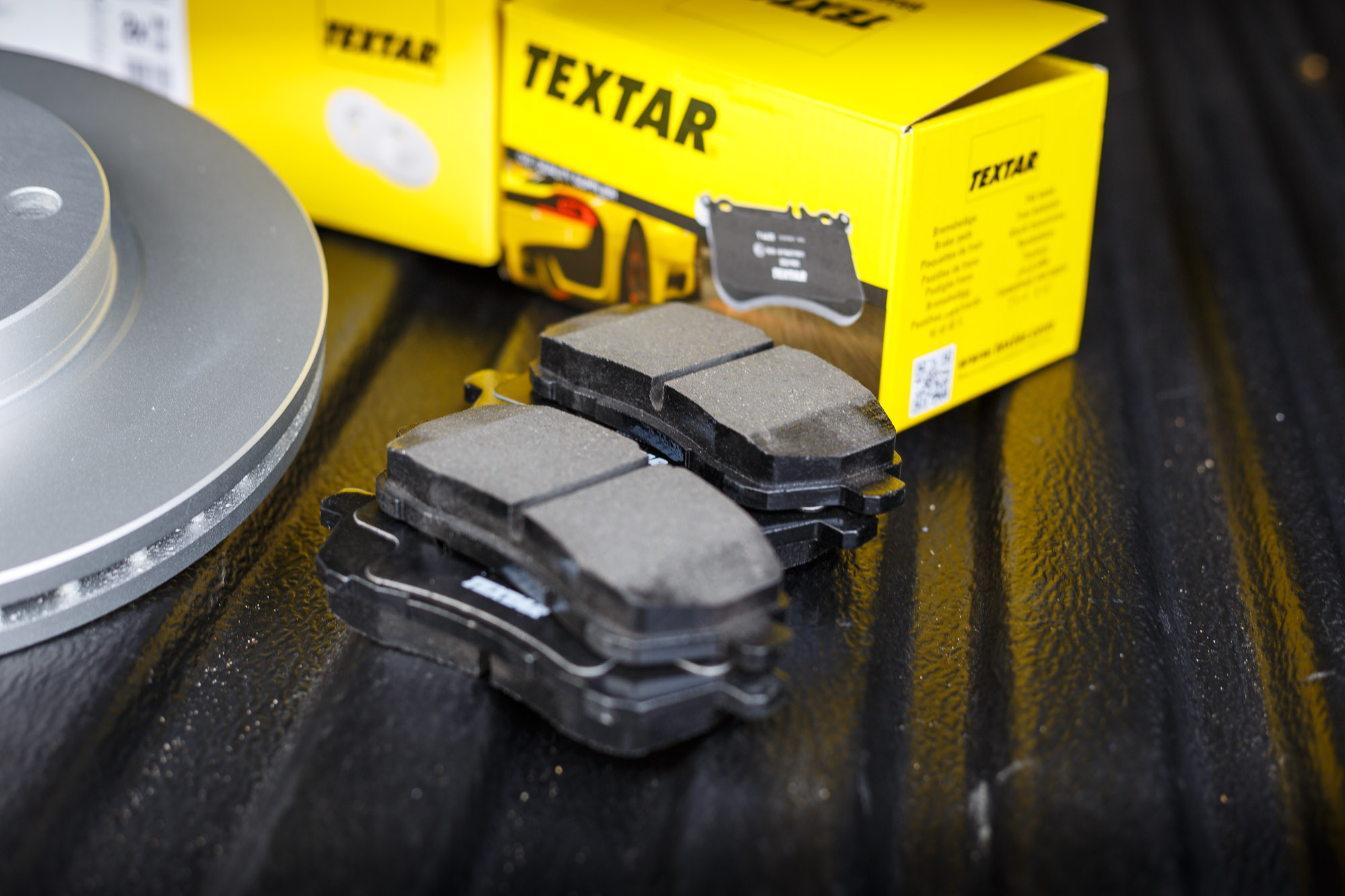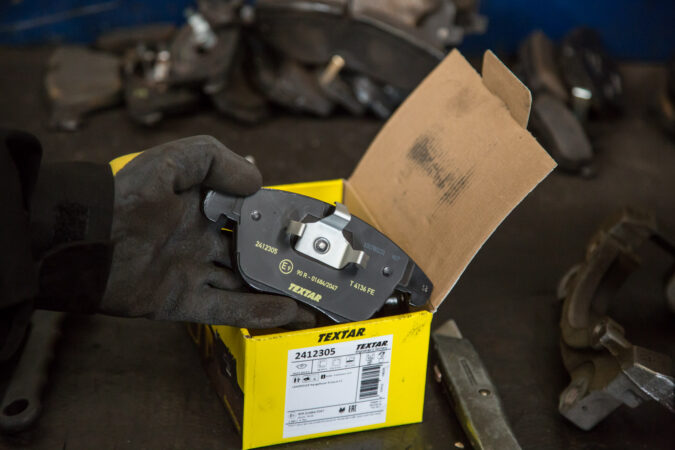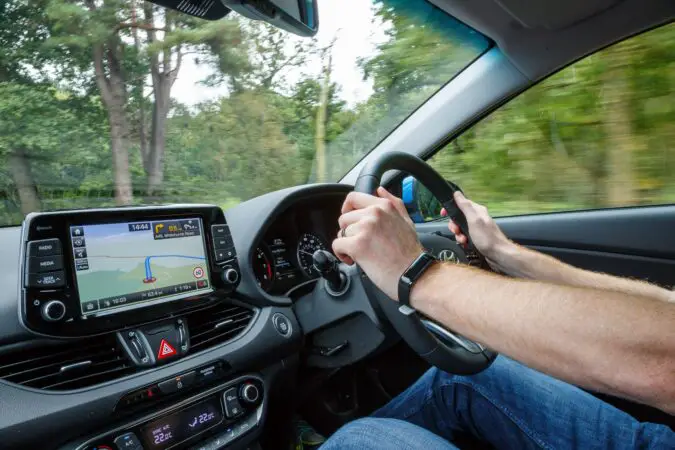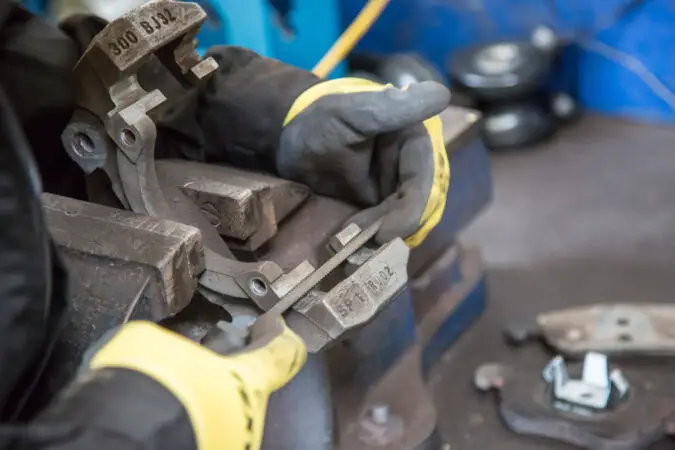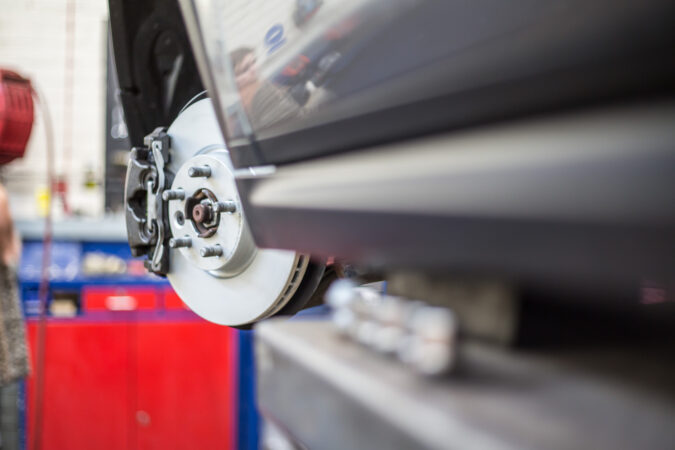You don’t need us to tell you that the braking system in your car is crucial for your safety. Like many components in your car, you will need to service them and replace parts over time such as replacing worn brake pads. But how do you know that you have worn brake pads and when to replace them?
This post will discuss everything about your car’s brake pads and the braking system in general. Here’s the table of contents to help you navigate:
How The Braking System Works
Before we get to the symptoms and repairs, let’s learn how the braking system works if you don’t already know. Understanding how the system works will help make sense of why you need to replace parts.
Most cars have a hydraulic braking system. This system consists of many components: the brake booster, the master cylinder, brake lines, calipers, brake pads, and brake rotors. The system works by using hydraulic fluid to engage the brakes, and here’s how the system works:
When you press the brake pedal, it will engage the brake booster via a piston to multiply the force applied by the driver. The other end of the piston connects to the master cylinder, which then forces the brake fluid to travel.
The brake fluid will travel through the brake lines which are usually a series of rubber hoses. Once the fluid reaches the caliper’s pistons, this will push the calipers which will then come into contact with the car’s rotors or also known as brake discs.
Inside the calipers are the brake pads and they will come into direct contact with the discs. This will slow down the rotation of the rotors, which slows downs the wheels and your car.
Both the brake pads and rotors experience a lot of friction when braking. As you’d expect, the friction will wear these components down over time and you will need to replace them. The brake pads will wear out more quickly, usually between 10,000 to 20,000 miles.
Types Of Brake Pads
So, that’s how the braking system work. Now let’s take a closer look at brake pads: each pad has a metal backing plate that attaches to the caliper, and a friction material that comes into contact with the rotors to slow the car down.
There are three types of brake pads: organic, ceramic, and semi-metallic. Organic brake pads are made of a mixture of rubber, carbon, fiberglass, and secured together by resin. This is the most common type of brake pad as they’re cheap to produce and won’t wear down the system too quickly.
Meanwhile, a ceramic brake pad is made from hard ceramic fibers. They are very durable and have better performance than organic pads, which is why you’ll often find them in performance and luxury cars. However, they are expensive, and they wear down the rotors quicker than organic brake pads.
Meanwhile, semi-metallic pads are made from metal shavings, such as copper, steel, brass, and sometimes graphite. They provide the most stopping power, which is why large trucks and SUVs, high-end performance cars, and race cars use them.
However, semi-metallic pads induce a lot of wear on the rotors, so they’re not ideal for long-term use. Additionally, they produce a lot of brake dust that results in squealing noises. This is why you’ll often hear race cars with semi-metallic pads squeal when they brake.
This makes them less ideal for road use as the noises are annoying, which is why manufacturers often choose ceramic pads for performance road cars when they need a good balance between performance and comfort.
Other Types Of Braking System
There are several other types of braking systems, two other common ones are the pneumatic and electric braking systems. They’re not quite as common as the hydraulic system, but let’s briefly touch on those as well:
A pneumatic braking system works similarly to a hydraulic system. However, rather than use hydraulic fluid, it uses an air compressor to apply pressure to the caliper’s pistons. Apart from that, it works the same as a hydraulic system. You’ll often find this system in semi-trucks, which is why you hear them making a hissing noise when they brake.
Meanwhile, an electric braking system is technically still a hydraulic system. However, the brake pedal is not physically connected to the booster. Instead, the brake pedal conveys electrical signals to the ECU to apply the brakes. This is why they’re often referred to as a brake-by-wire system.
This system isn’t very common, one famous application of the electric braking system is in the Acura NSX. Note this is different from the electromagnetic system which is a regenerative braking system used in many electric and hybrid cars to generate electricity to feed into the battery of the car.
However, these systems still utilize calipers, brake pads, and rotors to slow down the car. The difference lies in how these systems engage the calipers.
Signs You Have Worn Brake Pads
You will need to replace the brake pads once they wear to a certain point. You’ll notice some symptoms when the brake pads get too thin:
1. Grinding Or Squealing Noises
The most common symptom you have worn brake pads is usually a grinding or squealing noise when you apply the brakes. Depending on the condition of the pads and rotors, you may either hear a squealing or grinding noise or both.
If you haven’t driven the car in a while, you might hear a squealing noise when you brake the car. This is quite normal and is caused by debris, and it should clear after a few minutes of driving.
However, if the squealing noise persists or there’s a constant grinding noise when you brake, this means your brake pads are worn. The noises mean the pads are so thin that the metal plates are now contacting the metal rotors while you brake which results in the noise.
Sometimes the noise may be accompanied by vibration when braking. The brake pads aren’t causing this, rather, it’s usually because of uneven rotor surface. This happens when there’s uneven wear or there’s uneven pad material transfer to the rotors.
Either way, the rotor now has an uneven surface. The bumps or drops in the surface results in the vibration you’re feeling when braking the car. This will happen over time, and you’ll have to replace the rotors in severe cases. But resurfacing the rotors may suffice in some cases.
2. Spongy Brake Pedal Feel
You should feel resistance from the brake pedal when you press it. This means the brake system is working well as intended. A spongy brake pedal means you feel less resistance when pressing the pedal, making the pedal feel “spongy”.
Worn brake pads can cause this spongy brake pedal feel. This is because as the pads get thinner, you need to press the pedal deeper for the pads to come into contact with the rotors, hence the spongy pedal feel.
However, keep in mind that a spongy pedal feel can also mean that the brake fluid isn’t reaching the calipers properly. When the fluid isn’t reaching the calipers, it will result in a spongy brake pedal hence the need to press the pedal harder and deeper.
There are several reasons why this might happen, such as a bad master cylinder or caliper pistons. Air in the braking system can also cause this as it can prevent brake fluid from flowing properly.
In the case of air in the system, you will need to bleed the brakes. Additionally, you should inspect the system for any cracks or ruptures in the brake lines, as this is usually the reason air got into the system in the first place.
3. Longer Brake Distance
This may be hard to notice if you’re not a keen driver, but you might notice it if your brake pads are really worn. As mentioned, the brake pads may wear to a point where the metal plates are now coming into contact with the rotors when you brake.
Not only does this result in a squealing noise, but it will also make your brakes less efficient. The metal plates on brake pads are not designed to stop the car and will increase stopping distance greatly.
4. Scratches On The Rotor Surface
The brake rotors are supposed to have a smooth surface. If you see scratches on the surface, this is likely because the pad’s metal plates are coming into contact with the rotors resulting in scratches.
You can visually inspect the rotors without taking off the wheels. If you see scratches on them, this is a good indication that you need to replace the pads before they can do any more damage to the rotors. They’re more expensive to replace than brake pads.
5. Wear Indicator
Some modern cars may have a wear indicator that comes on if it detects the brake pads are too thin. This isn’t very common though, and you’ll likely only find this indicator in luxury cars.
Note that this is different from the ABS warning light. Worn brake pads will not trigger this light to come on. If you see a light on your dashboard that says ABS, this means you have a different problem with your car’s braking system, usually with a sensor relating to the Anti-lock Braking System (ABS).
If you see this light on the dashboard, you can use an OBD scanner to see the trouble codes that triggered it. This trouble code will tell you what triggered the light in the first place.
For example, a C0221 code means that there’s a problem with the front-right wheel speed sensor. We recommend reading our ABS warning light guide to learn more about how to solve the problem.
Worn Brake Pads Replacement Cost
So, now you know the signs of worn brake pads. How about the replacement cost then? The total cost will depend on how many brake pads you want to replace and where you buy your brake pads from.
Brake pads will cost between $50 – $100 for each axle (two wheels) depending on where you buy them from, and buying from the dealer are likely to be on the higher end of the spectrum.
Meanwhile, labor is usually around $100 depending on labor rates. Additionally, you can also expect the labor to double if you’re changing the brake pads on all four wheels.
In total, you can expect the cost to be as high as $200 for a single axle. And about $400 to replace the brake pads on all four wheels. If you need to save money, consider getting a brake job from a general auto repair shop rather than at a dealer. Labor is often cheaper, and they rarely charge a premium for parts.
The key thing is to make sure that their brake pads come with a warranty. We wrote an article about brake job prices in various auto repair chains, and you should check it out to compare prices. You can also save money by doing the replacement job yourself, and we’ll get into that after this.
Should I Use Ceramic Brake Pads?
Unless your car came with ceramic pads from the factory or you’ve made significant performance upgrades, then there’s no need to do so. Ceramic brake pads are intended for high-performance cars that need a good blend between braking performance and comfort.
They cost around $200 per axle before labor. If your car doesn’t have significant performance upgrades, you’re only going to waste your money buying ceramic brake pads. That being said, if you’re planning to install performance modifications, then there’s no harm in switching to ceramic pads now.
Bottom line, if your car came with organic brake pads, chances are that’s good enough. Just make sure that you buy quality brake pads from reputable retailers or preferably OEM (Original Equipment Manufacturer) so that you don’t compromise your safety.
DIY Worn Brake Pads Replacement
Doing a repair job yourself can help to save money, especially if half or most of the cost comes from labor. However, note that this is a moderate to difficult level job. If you’re not comfortable with the idea of taking apart and reassembling your brakes, we don’t recommend doing this on your own.
The braking system is essential to your safety, and messing up the repairs can compromise the safety of your car. Additionally, the exact steps may differ between make and model, and the instructions we’re going to provide are more of a general guide on how to do the job.
Bottom line, if you’re not sure of your mechanical skills, it’s best to leave this job to a professional. Now, if you’re sure you want to take on this project, let’s prep the car first:
DIY: Prep Work
The prep work to replace the brakes is quite simple:
- Put the car in ‘Park’ or first gear if you have a manual transmission. Engage the parking brake, and put wheel chocks.
- Jack up the car, and install jack stands. If you’re replacing the brake pads on all four wheels, start at the front and leave the rear wheels on the ground.
- Afterward, remove the lug nuts and remove the wheels. I like to put the wheels underneath the chassis for extra protection.
- Turn the wheels in the direction of the pads you want to change so you can gain easy access. For example, if you’re changing the left brake pads first, then turn the wheel to the left.
That’s it, that’s the prep work. All you need now are the new brake pads and common hand tools, and you’re good to go:
DIY Brake Pads Replacement
Let’s get straight into it:
- Undo the bottom bolt that holds the caliper. We recommend undoing only the bottom one which allows you to flip the caliper upwards. In any case, do not let the caliper dangle by the brake line.
- Remove the brake pads and their clips. The clips are at the top and bottom. Pry the clips with a flathead screwdriver to remove them.
- Prep the new brake pads and clips by applying anti-seize to the clips and the metal plates of the brake pads.
- Install the clips. The top and bottom clips may have a slightly different design. Check with the old clips to find out which one belongs where then install the clips.
- The caliper’s piston may need to be compressed to accommodate the new thicker brake pads. You can do this by using a brake compressor tool, which will be shown in the video below.
- Slide in the new brake pads into the brake pad clips, make sure that the wear indicator is on the top side. Put in the top part first, and then slide the bottom part in.
- Close the caliper, if it doesn’t close then you need to compress the caliper piston again.
- Reinstall the bolts and tighten them with a torque wrench. You need to tighten them to about 20lb-ft but check with your owner’s manual to be sure.
- Repeat the steps for the other brake pads.
The video above from ChrisFix is a great visual guide on how to do the job. He replaces the rotors in the process, so, if you’re planning to replace the rotors as well, you should watch the video above. It’s not the easiest replacement job, but it is doable with the right tools.
What If I Have Drum Brakes?
Drum brakes work similarly in the sense that used a couple of pads to slow down the rotation of the wheels. However, the “pads” are called brake shoes, and they sit and slow down the wheel’s rotation from inside the brake drums.
Additionally, they use a couple of springs to engage the brake shoes rather than pistons in the caliper system. Brake shoes typically last around 50,000 miles, which is more than brake pads do. However, they’re less efficient than disc brake systems which is why they’re not widely used, and mostly used from rear brakes.
We won’t get into the details on how to replace the parts and maintain drum brakes, as that’s a different topic than brake pads and deserves its own article. If you have drum brakes in your car, we recommend watching the video above from ChrisFix to learn more.
General Maintenance For The Brake System
Brake pads replacement is just one of several brake system maintenance that you should do. Here is the other maintenance you should do:
- Check the system every 12,000 miles. This includes checking the brake fluid (replace them if they’re dirty) and checking the brake lines for damage.
- Replace the brake fluid every 25,000 miles or according to manufacturer recommendation.
- Check the rotors every 60,000 miles. Resurface or replace the rotors as necessary.
- Bleed the brake lines if necessary. This usually needs to be done every 2 – 3 years.
That’s about it, the brake system doesn’t need frequent maintenance. The important thing is to pay attention to your car’s braking performance, and inspect them should you feel the braking performance is less than optimal. Doing an annual check on the system won’t hurt either.
To prolong the lifespan of your brake system components, make sure they’re always in good shape, which is why you should inspect them annually. One bad component can cause excess wear on other components.
Additionally, avoid carrying heavy loads unless necessary. Heavy loads in the car mean your car’s braking system will have to work harder to stop the car, increasing wear in the system.
Also, needless to say, drive carefully! Always keep a safe distance to the car in front. This way you can avoid heavy breaking situations that can wear down your brake pads and rotors quicker.
Facts on Brake Pads: Signs That Indicate You Need to Replace Them
- Brake pads are the removable surfaces that calipers use to make contact with the rotors during braking.
- Over time, the friction produced by the brake pads will wear them down, and they must be replaced to maintain brake system performance.
- Built-in “wear indicators” on most modern brake pads emit a screeching noise when the pads are worn down to a dangerous extent.
- Loose brake pads will begin to rattle, creating a clicking sound that rings out whenever the brake pedal is pushed or released.
- Brake fade is a common issue caused by overheating the brake pads and rotors, resulting in reduced friction and longer stopping distances.
- Unevenly worn brake pads can cause the car to pull to one side when braking, putting unnecessary stress on the steering rack, ball joints, steering knuckles, and wheel bearings.
- Glazing is an issue caused by overheated brake pads where the adhesive holding the brake pad together gets smeared across the rotor, causing the brake pedal to vibrate.
- If you hear a squealing, clicking noise, or the brake pedal vibrates, it is imperative to have your brake pads checked and replaced immediately to ensure safe braking.
- Not all brake pads are created equal, and it’s crucial to choose a high-quality brake pad that is appropriate for your driving needs.
- It is recommended to have your brake system inspected by a qualified mechanic at least once a year or every 12,000 miles to ensure safe operation.
Worn Brake Pads: Wrap Up
To summarize, brake pads are the component that comes into contact with your car’s rotor to slow down your car. They work by using hydraulic fluid to push the pistons inside the caliper which pushes the pads into the rotor and slows down the rotation of the wheels.
Over time, the friction material on the brake pads will wear down. Once it gets too thin, you’ll see symptoms like squealing or grinding noises when braking. In severe cases, the car may vibrate when you brake. Since this is crucial for your safety, you don’t want to postpone brake pads replacement.
On average, they cost around $200 – $400 to replace, depending on where you do it and how many brake pads you’re changing. You can save money by replacing them on your own.
Hopefully, this has been a helpful article and you’ve learned more about your car’s braking system. If you’re replacing the brake pads on your own, follow our guide above, and good luck!

